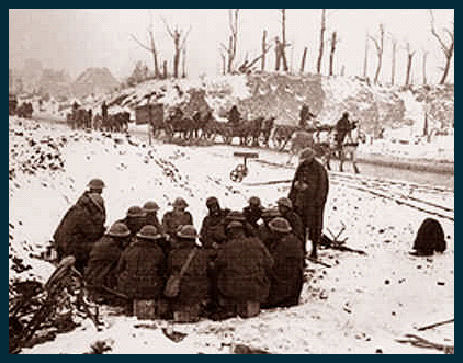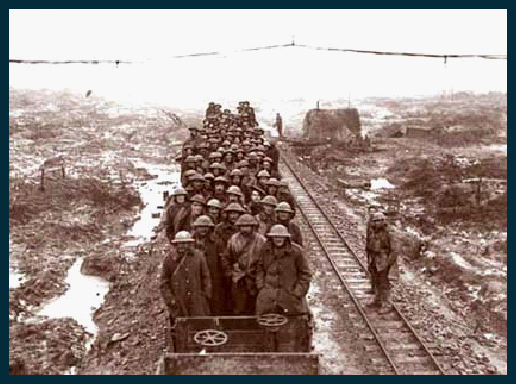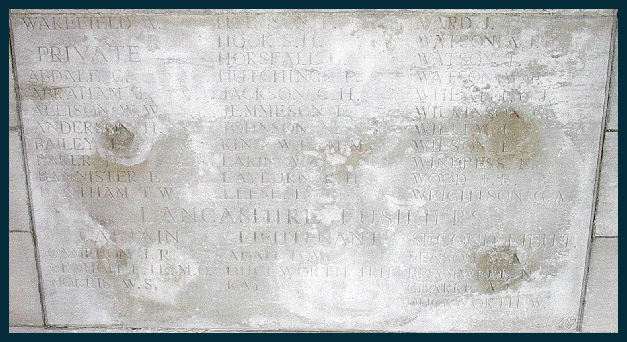Copyright © All rights reserved.



Thomas Wood

Thomas Richard Wood was born in the first quarter of 1889 and his birth registered in Malton. He was the fourth son of William Sunley and Phoebe (nee Trennum) Wood who married in the third quarter of 1872 in the Pickering area.
Their first three children were born in Sinnington, presumably living with or near Phoebe’s parents. The next two were born in Norton, where they are recorded living at the “Dog and Duck” pub on Scarborough Road in the 1881 census.
Presumably they moved to Malton during the latter years of the 1880s as Thomas was born in Malton, presumably at 54 Old Maltongate where they seem to have been resident in 1891.
1891 Census – resident at Old Malton Gate
WOOD, William S, Head, Married, M, 48, Gardener, West Ness Yorkshire,
WOOD, Phoebe, Wife, Married, F, 42, , Sinnington Yorkshire,
WOOD, Mary C, Daughter, Single, F, 16, General Servant, Sinnington Yorkshire,
WOOD, John W, Son, , M, 14, Upholsters Apprentice, Sinnington Yorkshire,
WOOD, Robert, Son, , M, 13, Masons Apprentice, Sinnington Yorkshire,
WOOD, Arthur T, Son, , M, 10, Scholar, Norton Yorkshire,
WOOD, Charles H, Son, , M, 8, Scholar, Norton Yorkshire,
WOOD, Thomas R, Son, , M, 2, , Malton Yorkshire,
They were still there in 1901 though Robert had left home and their youngest daughter Eva had now arrived.
1901 Census -
WOOD, William Sunley, Head, Married, M, 57, Gardener Domestic, Ness Yorkshire,
WOOD, Phoebe, Wife, Married, F, 52, , Sinnington Yorkshire,
WOOD, Mary Catherine, Daughter, Single, F, 26, Servant Domestic, Sinnington Yorkshire,
WOOD, John William, Son, Single, M, 24, Upholsterer, Sinnington Yorkshire,
WOOD, Arthur Trennur, Son, Single, M, 20, Gardener Domestic, Norton Yorkshire,
WOOD, Charles Henry, Son, Single, M, 18, Groom Domestic, Norton Yorkshire,
WOOD, Thomas Richard, Son, Single, M, 12, , Malton Yorkshire,
WOOD, Eva, Daughter, Single, F, 8, , Malton Yorkshire,
By 1911 Thomas had got a job as cellarman for a wine merchant. This would presumably have been working for Edward Rose who seems to have been the only wine merchant in Malton at the time and ran a business on the Market Place at “the Vines.”
1911 Census -
WOOD, William Sunley, Head, Married, M, 68, Gardener Domestic, W Ness Nunnington Yorks,
WOOD, Phoebe, Wife, Married 38 years, F, 63, , Sinnington S O Yorks,
WOOD, Charles Henry, Son, Single, M, 28, Groom Domestic, Norton Malton Yorks,
WOOD, Thomas Richard, Son, Single, M, 22, Cellarman Wine Merchants, Malton Yorks,
WOOD, Eva, Daughter, Single, F, 18, , Malton Yorks,
Thomas was already a member of the territorials when war broke out and is listed by the Malton Messenger among the men who were among the first to leave Malton with the 5th Battalion.
“DEPARTURE OF MALTON TERRITORIALS -
Scenes which will be long remembered by the inhabitants of the town were witnessed in Malton on Wednesday, when the Territorials (“H” Company 5th Battalion Alexandra Princess of Wales’ Own Yorkshire Regiment) marched from the headquarters in Old Maltongate to the railway station. The men quickly responded to the call and were ready on Tuesday night. Many of them were in the streets until a late hour, mingling with the crowds which gathered near the Messenger office and other parts of the town. It was at first understood that they would leave for an unknown destination at 8.30 on Wednesday morning, and the streets presented a busy scene; gradually, however, it became known that they were to leave at 12.30, and long before that time the streets from the headquarters in Old Maltongate to the Railway Station were lined with people who were eagerly discussing the grave crisis.
About half-
It was impossible to admit all the followers into the station but a large number succeeded in in gaining admission, mostly those who had relatives in the ranks. The men were very cheerful, and there was a good deal of hand-
In the brief interval a representative of the “Messenger” held a conversation with Lieutenant Pickles who stated that they were going on to Scarborough to await orders.
At about 10 minutes to one o’clock the train arrived, and after more hand-
The 1/4th and the 1/5th Battalions of the Yorkshire Regiment were both in the 150th Brigade of the 50th [Northumbrian] Division and their activities in the First World War were very similar. Both Battalions went to same areas at the same time and fought in the same Battles -
Such were the losses during the War that the personnel of both Battalions changed several times. National conscription was introduced at the beginning of 1917. Bulk transfers were sometimes made from one Battalion to another. The Battalion that was decimated on the Aisne in May 1918 was, therefore, unrecognisable from the one that had embarked for France in April 1915 and had by then lost the biggest part of its purely local attachment.
In 1915 the Battalion became part of 150th Brigade, 50th (Northumbrian) Division. In early April the Division was warned that it would go on overseas service and entrainment began on 16 April, landing at Boulogne. By 23 April the Division had concentrated in the area of Steenvoorde. It had arrived just as the German army had attacked at nearby Ypres, using poison gas for the first time, and was rushed into the battle. The Division then remained in France and Flanders and took part in the Second Battle of Ypres.
In February 1916 the 5th were in trenches in the Ypres Salient until 12th February when they were relieved by 4th East Yorkshires and went into close support. Through the Spring of 1916 they continued to alternate between trenches and support sustaining a constant stream of casualties and losses, first around Ypres and then at Kemmel.
In August, the 5th Battalion was moved to the Somme area and after a few weeks of rest and training left Millencourt on 5th September for the Trenches in front of Bazentin Le Petit where they sustained dreadful losses. After the carnage of September, the Battalion moved into billets in October to re-
The beginning of 1917 saw the battalion moved to Arras and there sustaining further heavy losses. Through August and September they continued to undergo heavy bombardment and regular severe casualties. At the end of September they were moved back to the Ypres Salient near the frontline. Casualties continued high and in the last four days of October 17 men died and over 100 were wounded.
At the start of November the Battalion was withdrawn from the front line to Roussel Farm where they were supplying working parties to 447th Field Coy RE, 7 Field Coy RE and 2/2nd Northumbrian Field Ambulance. On 7th November the Battalion marched to St Sixte Area [Salem Camp], where they remained for a couple of days, resting. On the 9th they came under gas attack. After this the rest of November was spent in training.
The Russian Revolution and that country's subsequent withdrawal from the War in the East had allowed the Germans to transfer troops to the Western Front. On the 21st of March 1918 they were ready to launch 76 Divisions against the 28 of the Allies along a 50 mile Front in the St Quentin area. The plan appears to have been to split the British and French Armies, capture the Channel ports and thus cut off the British Army and prevent further landings. The news that America had belatedly entered the War meant they had to take decisive action before they were outnumbered. The 4th Yorks Btn had been thrown right into the centre of this onslaught.
Rumours that the Germans were planning a major offensive were treated as the Generals "crying wolf" as they had so often before. In the early hours of 21st March the Germans, launched a bombardment aimed at taking out Allied command posts, communications and Artillery. This was quickly followed by specially selected Stormtroopers, under the cover of a dense morning fog, attacking the Allied Front line and causing panic by keeping going. Mopping up was left to Troops in reserve. Much of the area over which the attack took place had just been taken over by the British and defences had not been prepared in depth across the wrecked ground of the old Somme battles.
At night the 150th Brigade were taken by train to Brie and at midnight commenced a six hour march to take over the rear zone of defences in the Green Line near Harcourt. The 4th Bn were in the Brigade centre with the 4th East Yorks to the Right and the 5th DLI on the Left. The 50th Division were in Reserve to the XIX Corps and the position it was ordered to take up was between the Omignon and Cologne Rivers on a Front which had been partially barbed wired.
By 8.0 a.m the following morning the Battalion was in the Green Line with the East Yorkshires on their right and the 5th Yorks Btn in Reserve. Again it was a thick misty morning. Two Divisions in front were ordered to retire and soon streams of men, horses, tanks, guns and limbers were coming through and the Green Line became the Front Line. At 6 p.m the enemy attacked and the Btn was forced to give ground to a position about 800 yds West of the Green Line. It was here that the Commanding Officer, Lt Col Charlton and Adjutant Capt J.S. Bainbridge who had gone up to rally the left Company were killed. Companies had lost touch with one another, but fortunately the enemy's attack stopped short and no further advance was made.
The Battalion war diary for 23rd March records : "Early in the morning Orders were received to retire to a line running from Vraignes to Bouvincourt.
Here the 4th East Yorks and 5th Yorks were in the Line and the 4th Yorks were in Support."
During the morning Orders were received to retire on a prepared line on the River Somme. Instructions were given for Battalions to cover the withdrawal of the other two.
The East Yorks reported that these orders were received four hours late, by which time they were being outflanked by the enemy.
“ The retirement of the 4th East Yorks and the 5th Yorks Btn was covered by the 4th Yorks, who fought rear-
At Brie enormous fires were burning and ammunition dumps which could not be removed were blown up. Huts, camps and aerodromes were all burning on the East of the River Somme. From the Green Line the Battalions of the 50th Division fought and retired a distance of ten and a half miles in eight hours, the greater part of the distance being covered in extended line over open country with rear guard actions being taken.
“ On reaching the River Somme, the Brigade Commander ordered one Company to hold the high ground East of Brie until all British troops were through Brie. Afterwards this Company covered the retirement of the other troops across the River Somme and held the enemy in check until all the bridges except had been destroyed. They then withdrew across this bridge which was immediately destroyed."
The Brigade narrative states that the 4th Yorks Btn had had to fall back almost immediately the 4th East Yorks and 5th Yorks Btn had retired, as the enemy came on so rapidly after the last Btn had passed through.
The Btn less the Company which had covered the retirement joined the rest of the Brigade at Villers-
It was in this action that Thomas Richard Wood was killed. His body was not recovered and he is commemorated on the Pozieres Memorial
The Army Register of Soldiers effects records him as “presumed dead” and payments were made to all his siblings, as both his parents had died in 1915.
He is commemorated on the town memorial and in St Leonard’s Church.
It is possible that it was at this point that Thomas was transferred from the 5th Battalion to the 4th. Certainly at this time the 4th was very short of men and they received a draft of 172 O.R. at about this time. It may not have been until the re-
At the beginning of December the 4th battalion marched to Le Bas and then travelled by train to Brandhoek, about 7k to the West of Ypres. The next day they marched to Whitby Camp and were used as Divisional Working Battalion. On 24th December they were in the front line for a few days before moving back to Whitby Camp. They had suffered considerable losses both through shelling and gas.
On New Year ’s Day 1918 they moved up to Potijze by bus from Brandhoek in the morning and relieved 9th Btn D.L.I. in Support in the Seine area at night. The weather was cold with the ground frozen to a depth of at least one foot.
During February they travelled by light railway to the Front, where they relieved the 5th Btn, Border Regiment.The weather was extraordinarily fine and warm for the time of year.The enemy was quiet and a good deal of barbed wiring was done in front of posts. And throughout February casualties were very light.
At this time the reorganisation of British Divisions took place with Infantry Battalions being reduced from 12 to 9 as it was becoming harder to find personnel for reinforcements. The 150th Brigade was now formed by the 4th and 5th Yorks Btns and the 4th East Yorks. On 21st February they were moved by train to Wizernes, way behind the Front to the South West of St Omer. From there they marched to Esquerdes, "where the inhabitants gave us a warm welcome. They had never before known the same Btn to return to the same village -


